Mermaids of South Korea: Haenyeo (Women Divers) Traditional Ecological Knowledge, and Climate Change Impacts
Oregon State University Oregon Climate Change Research Institute, 370 Strand Agricultural Hall Corvallis, Oregon 97331 shatfield@coas.oregonstate.edu
Institution for Marine & Island Cultures, Mokpo National University landskhong@gmail.com
Abstract
The Haenyeo (women divers) from the many islands of South Korea are internationally known for their diving for abalone, but also harvest many other ocean species. A longstanding part of history, particularly amongst Korean islands, Haenyeo have been actively diving for centuries. These women have intricate knowledge of their environments, and their specific Traditional Ecological Knowledge (TEK) is exceptional, but quickly disappearing. The Haenyeo are a distinctly unique and highly specialized group of women whose TEK systems are integrated with, and reliant on, the landscape they traverse, both in as well as out of the sea. These cultural groups are intricately woven into the fabric of their systems, and are on the frontline of environmental systems, passing TEK information on in traditional manners, but are also flagships for island environmental change developments. This TEK information is being fragmented and is at risk of being lost with the current structure of environmental shifts occurring.
Keywords
Haenyeo, women divers, Traditional Ecological Knowledge, TEK, Traditional Knowledge, TK, Indigenous Knowledge, IK, South Korea, Islands
Introduction
The aim of this research was to ascertain what information the Haenyeo had noted through Traditional Ecological Knowledge (TEK) methods, any specific relativity to changes regarding climate change, and how island culture is being maintained via TEK specifically in regard to Haenyeos’ work. Traditional Ecological Knowledge (TEK) has been defined in many ways. For the purposes of this paper, it is defined as such:
“Traditional Ecological Knowledge (TEK) is defined as the application of the specific area of Indigenous Traditional Knowledge and Indigenous Science Knowledge that specifically relates to the environment in a given traditional homeland of Indigenous groups and/or Usual and Accustomed (U&A) areas. This may include but not limited to: botany knowledge, medicinal application (collection and/or administration), hunting, fishing, gathering, processing of material(s), caretaking such as burning, coppicing, thinning, astronomy, phenology, time, ecological markers, species markers, weather and climate knowledge.” (Chisholm Hatfield, 2018)
Traditional Ecological Knowledge is a longstanding process which is closely associated with traditional indigenous groups who are tied to the homeland areas of which they reside, or frequent over extended periods of time. These geographic areas provide a foundation for such groups’ identity, culture, history. Transmission of TEK is based on lengthy generations-long oral history, which often includes sustainability practices, environmental changes, developments, and historical influences.
Because of the intricate, longstanding knowledge systems that Haenyeo possess, and which are passed on in traditional oral behaviors, it is vital to assess the TEK, biodiversity, and changing ecosystems that these women are noticing (Haenyeo Museum, 2014), particularly since their cultural adherence to oral transmission of Traditional Knowledges remains vital. The Haenyeo have been active for centuries and some historical references place their diving activities as far back as 1629 (Kyeonghwa et al, 2015). These elite group of women free dive, sans diving aparatuses, for marine natural resources such as seaweeds, conch, octopi, and shellfish. They have typically been closely associated with abalone collection, often termed in international media as “abalone divers”. The Haenyeo work in, and are closely tied to, the environmental systems and so are natural stewards of seascapes and landscapes, and have a longstanding reciprocal relationship with their environments, and engage in active Traditional Ecological Knowledge practices.
Traditional Ecological Knowledge (TEK)
Traditional Ecological Knowledge (TEK) is often expressed more richly and articulately in island cultures because of the close proximity they maintain with their environmental systems (Lazrus 2012, Adger et al 2005, Morss et al, 2011, Chisholm Hatfield 2018). Often these island populations are indigenous to the islands they inhabit, and maintain cultural traditions that have been lost and/or abandoned by other communities or individuals who have migrated and settled on the mainland. Ocean resources are a mainstay food base for Korean culture, as well as vital to traditional cultural value systems. Because of this reliance, islanders which include the Haenyeo, are vital to the overall economic welfare, and arguably a foundational cornerstone of, and for maintaining, Korean culture (Lee 2014, Ko 2010). TEK stories of indigenous groups are well documented and references are often accompanied by traditional food and adaptive capacity information or referencing (Ko 2010, Byun, 2015, Lee 2018). This information includes food items that were easy and/or difficult to obtain, and/or that were obtained in certain seasons and/or locations. Natural resource food items and sustainability efforts of biodiversity maintenance is a common attribute of place-based peoples. Since these food items hold higher intrinsic and cultural meaning for place-based groups, natural resources are of high content and hold multiple levels of meanings. The Haenyeo are vital to ongoing sustainability efforts, as well as being an excellent source of information for these issues, since they are maintaining their longstanding and high levels of TEK.
Five islands were visited to interview Haenyeo for this research project in search of TEK that exists and is employed by Haenyeo, along with TEK which is evident in island cultures for the wellbeing and maintenance of overall culture. The researchers also looked for any evidence of climate change events that may be impacting culture in any manner. Islands visited for this research with Haenyeo included: Cheongsando, Yeoseodo, Jeju, Saengildo. Udo.
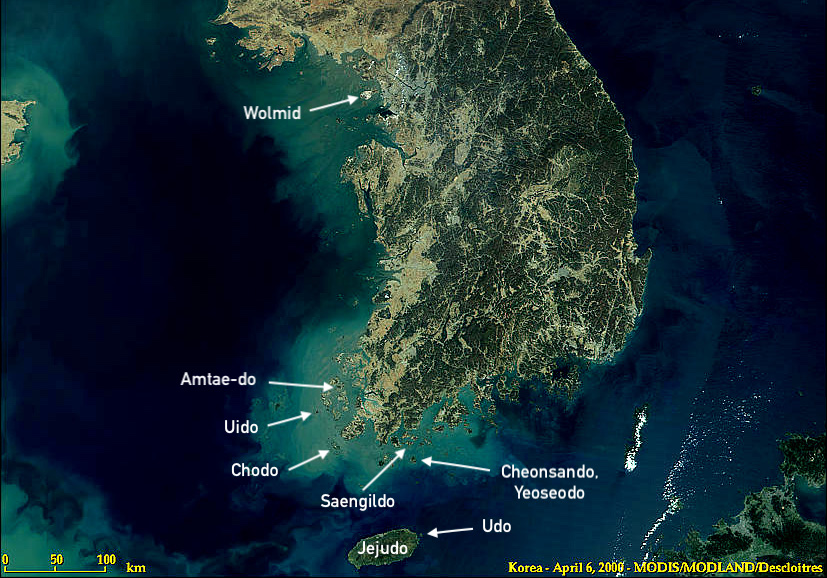
Climate change can be viewed as one underlying driver of change in animals, plants, and other aspects of nature, which in turn can affect expressions of indigenous culture. Previous work (Lynn et al 2011, McGregor 2002, Lazrus 2012) has examined changes in abundance of key species in response to climate variability and change.
The goals of this research were to investigate the Traditional Ecological Knowledge, the observations, possible climate change events, and potential adaptive strategies of island populations as they were illustrated and exemplified via Korean culture in a variety of formats.
Initially, we expected to focus on the more visible expressions of TEK which often include and are represented through cultural behaviors. Such behaviors include songs, stories, dances, artworks, and ceremonies, but developing results exceeded these sought out visible expressions. In the next section, we summarize our research design; in section 3, our results; in section 4, we connect those results to the scientific literature where possible; and offer conclusions in the last section.
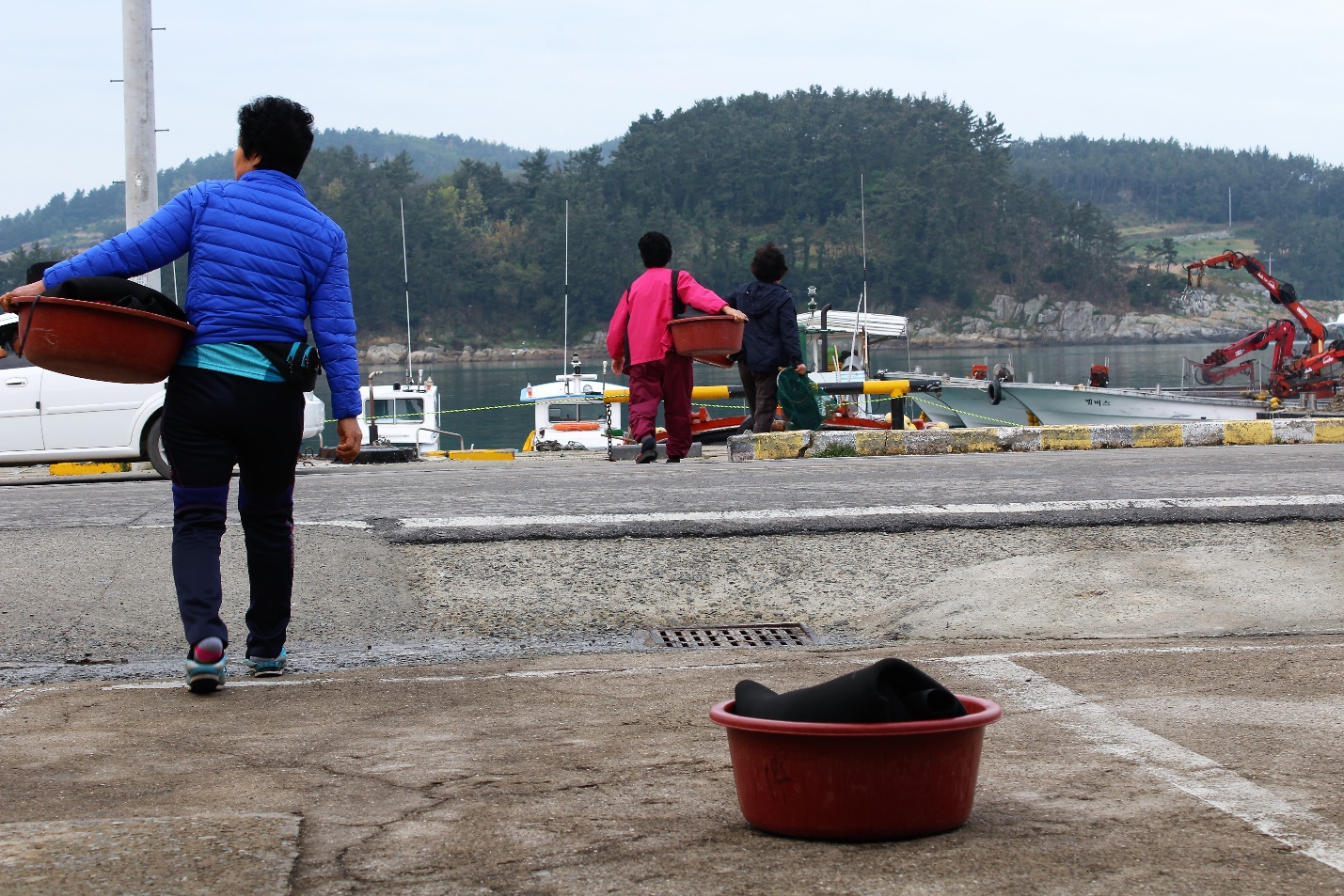
Research Design
Snowball sampling was the primary methodology technique used when contacting Haenyeo for interviews. Snowball sampling is a social science methodology which can include ethnographic documentation through oral interviews. Professor Hong initiated contact with Haenyeo communities and established meeting times. Individuals identified as having information critical to this research study were contacted through Professor Sun-Kee Hong. All conversations and interviews, were initiated after oral consent was obtained via interpreters and/or directly via researchers. Travel schedules to visit relevant cultural island sites, cultural collections, as well as individuals in coordination with staff and interviewees was coordinated and established via Professor Hong. Visits scheduled honored recognition of pertinent traditional cultural protocols concerning timing of when it is most appropriate to discuss specific cultural topics through oral discourse.
Interviews were audio recorded and notes were taken during interviews. Common practices, behaviors, and areas of culture that are most likely affected were outlined to watch for indications of occurring, and observed. These topics were addressed first to draw information from any of the following: individuals, behaviors, events, and structures in traditional cultural areas. Topics and information such as collecting, fishing/shellfish, ocean practices, were also noted to be able to discern any notable environmental changes that might have occurred previously, or that might be presently occurring. From the information gathered based on these topics, directed purposeful sampling occurred. Purposeful sampling is widely used in qualitative research for identification and selection of information in situations where abundance of data exists that is directly related to the topic(s) of interest. This process identified key features that held important cultural knowledge and assisted with identifying individuals who could outline the interplay with tradition, cultural practice(s), and the natural environment. Representational and contributory information from relevant cultural areas such as art murals, museum documents, and community indicators were also selected as illustrating the demonstrated utilization of TEK, culture, and possible climate change event impacts.
Research Questions
Open ended questions were posed to Haenyeo asking about collection practices, their knowledge of resources, and any changes they have witnessed regarding environmental, species, and/or natural resources. The following general overarching question categories were posed when needed for prompts to gather additional details during the interview. Further questions evolved out of these categories depending on specific and individual cultural practices, as interviews warranted. Not all questions were asked, and in some interviews none of the questions were asked because the interviewees readily offered information before questions could be asked, which met the criteria.
- Do you have to move/migrate to find foods or collect?
- Do you notice a change in the ocean?
- Do you notice a change in the ocean foods and plants?
- Have you adapted to changes in the environment?
- Are there any foods/traditions/places that you cannot eat/go/practice or that have stopped because of a change in the environment?
- Have traditional gathering practices changed?
- Have any adaptations occurred for collecting?
Interviews were conducted in person and notes were taken via interpreters and first language speakers due to specific, difficult speech dialects that Haenyeo speak. Notation documents when taken include translation of interviewees' emphasis, inflection, intonation, pausing, and stressors of the interview they provided. Environmental markers and TEK indicators that were expressed by Haenyeo were earmarked.
The objectives and work incorporated Traditional Ecological Knowledge (TEK) and Ethnographic methodology of Haenyeo and direct relation to guide and complete the research project through observation, cultural adhesion, semi-structured oral interviews, assessment of historical information, and artifact documentation (museums, photographs, recordings). TEK is based on observation of environmental surroundings over long periods of time, application and utilization of longstanding environmental knowledge, and is an integral aspect of indigenous cultural knowledge. Much of any given indigenous culture is holistic, therefore, it is vital to combine TEK in conjunction with western scientific techniques in order to achieve a fuller understanding of both the culture and the research. This project relied on social science methodologies which are highly efficient tools for collection and analysis of research on human subjects’ culture in indigenous populations.
The research primarily incorporated Traditional Ecological Knowledge (TEK) as it is expressed and presented in Korean culture in specific relation to the Haenyeo culture/subculture. TEK is based on utilization of Traditional Knowledge practices which includes observation of environmental surroundings over long periods of time. This is an integral aspect of indigenous cultural knowledge, particularly when populations have been living in a manner that has been closely tied to natural resources and in a communal, societal-focused manner. The Haenyeo of South Korea have been diving and engaged in a reciprocal relationship with their environments since time immemorial. The topography which documented harvesting of abalones, was written in 1629 by Lee Gun (Haenyeo Museum, 2014). Indigenous culture is historically holistic and, therefore, it is important to pair TEK with other more commonly-held mainstream science techniques in order to achieve a fuller understanding of the culture. It has been well documented in various formats (visual, historically written, pictorially) that the Haenyeo have passed down information regarding environmental conditions and natural resource conditions in classic TEK formats.
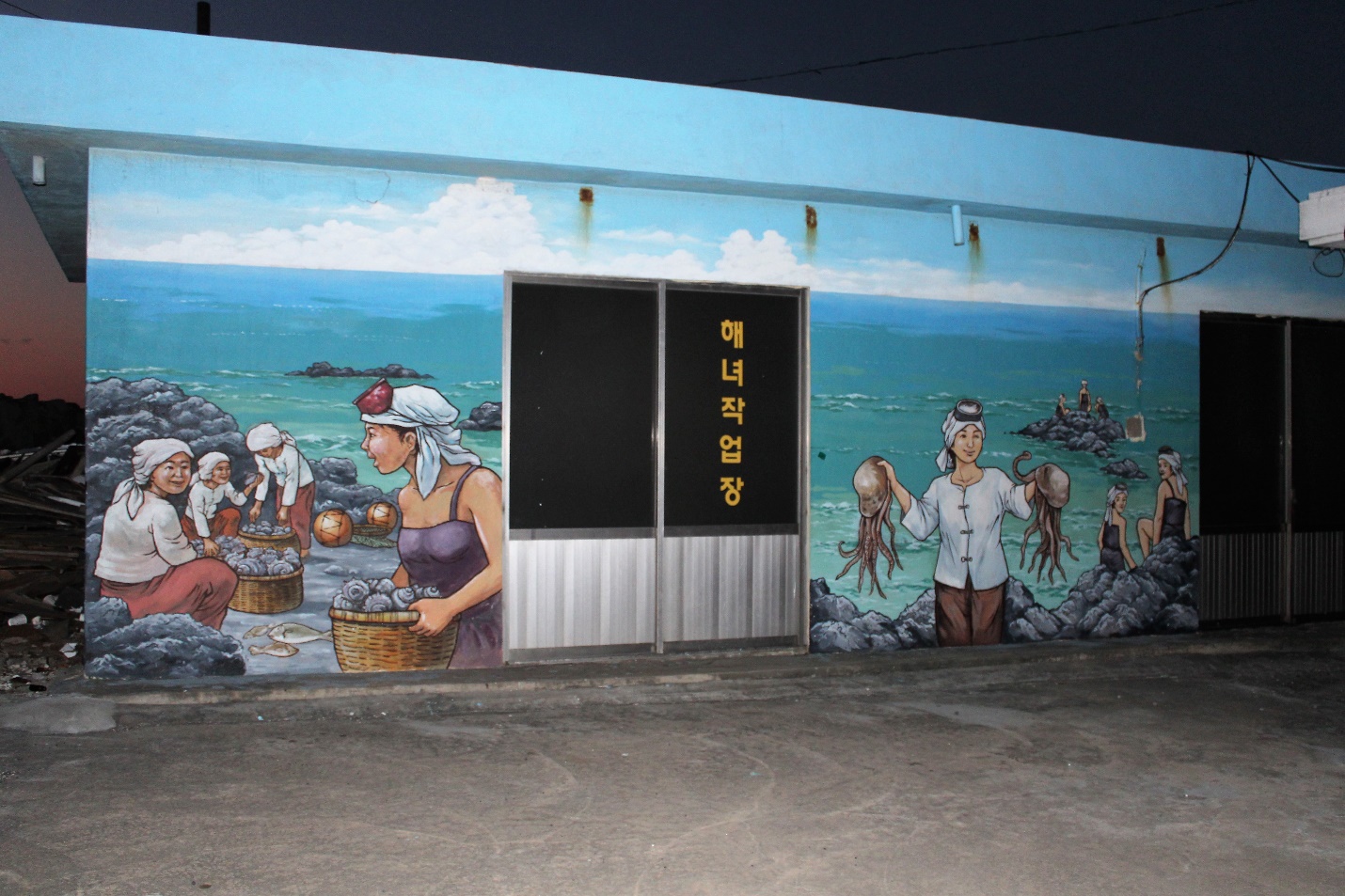
Research objectives
The overall research objective of this research was to identify and observe the behaviors and patterns of South Korean traditional divers’ (Haenyeo) TEK as well as traditional culture attributes and patterns that are currently, or have been apparent, or those that have been shifting in abundance, collection, performance, or facilitation to the point of altering traditional mannerisms. Any climate change impacts that have been attributed, or gave rise to adaptation measures were also investigated. Methods selected to facilitate this were as follows:
- Interviewing Haenyeo from the chosen islands and document their responses about cultural impacts viewed from a Traditional Ecological Knowledge (TEK) lens.
- Comparing responses and adaptation measures outlined by island Haenyeo.
This study was designed to examine changes in response and attitudes about patterns and/or behaviors that have been adjusted or are in flux as a result of natural resource changes as indicated by long term observation and interaction with the environment. In addition, the intent to collect and document Traditional Ecological Knowledge (TEK) as it pertains to culture was strived to be achieved. Interviewees were not asked to speculate on any patterns, terminology, climate change impacts, or consequences as a result thereof. Any causal chain linking is preliminary and would require further in-depth research to examine the extent of such and impact and/or possible adaptation measures.
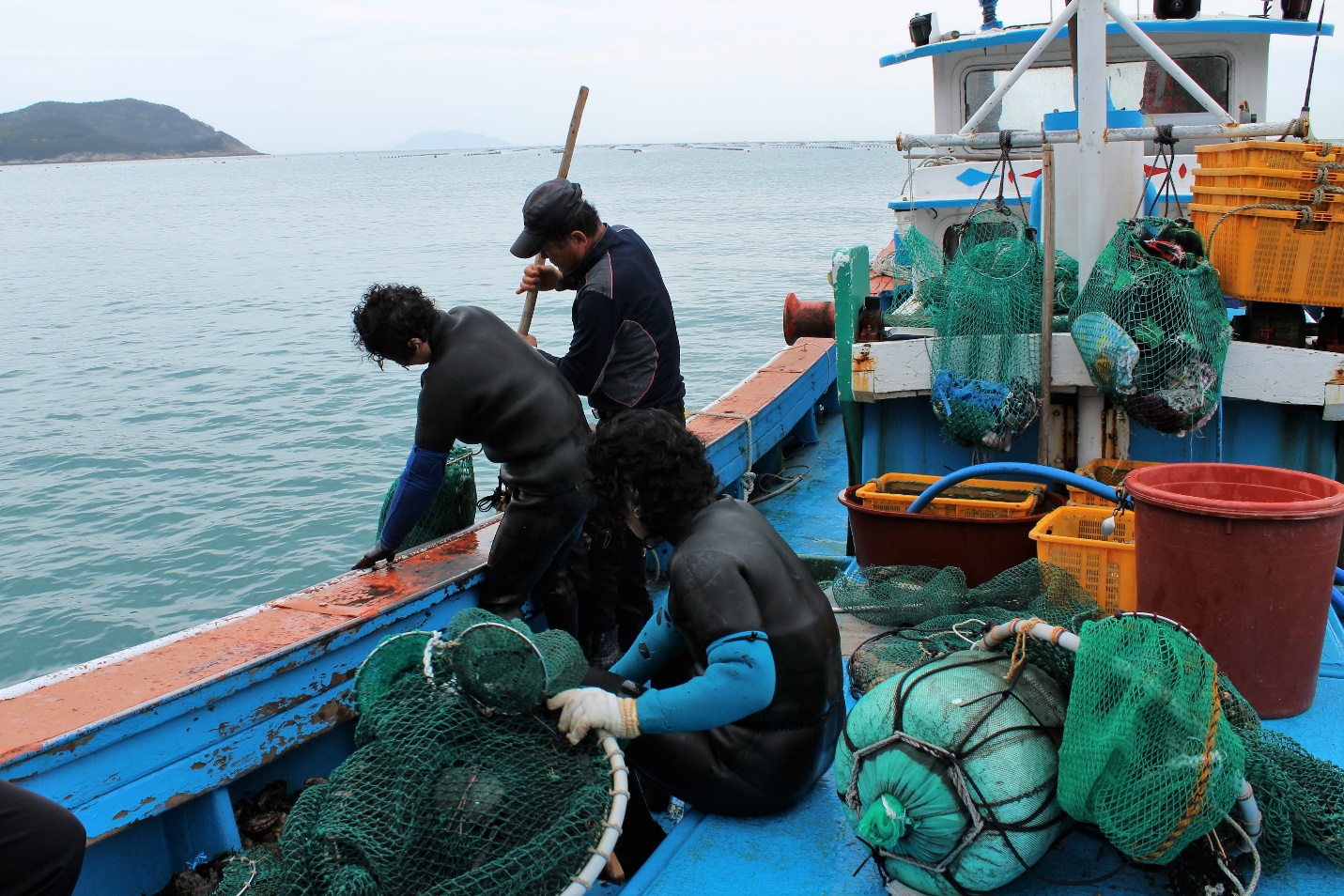
Results
Our analysis of the interviews suggested the following four significant conclusions:
1. Haenyeo have a highly developed environmental acuity, ability to read environments and document information on environmental changes.
The Haenyeo have an incredibly honed ability to understand multiple facets of their environmental system. The longstanding ability to pass down the intricate TEK of the sea, for both observations, and changes, is clearly vital to their understanding, ability facilitating, and harvesting of natural resources that their craft is relied upon (Haenyeo Museum, 2014). Not only do the Haenyeo hone this ability for their local systems, but this environmental systems processing occurs for all Haenyeo.
Because of the high level of acuity these women possess, it has been acknowledged that this can only be developed through longstanding TEK practices. Through opportunities such as diving schools which are now offered, women can learn the art of diving and integrate into the collective culture and practices. These behaviors are not termed TEK specifically, but the practices and utilizations of centuries old longstanding knowledge data systems are continued.
Their ability to understand phenology and implement sustainability practices when the profession was still new, as well as continue to organize harvest schedules for maximum benefit of all, indicates a expansive understanding of the environmental systems which work in conjunction with one another (Haenyeo Museum, 2014).
2. Collection of resources has steadily declined, change in ocean has been noted.
These women are one aspect in an ecological system that is environmentally-focused, but are the first line of stewards who are seeing impacts to the natural resources and the ecosystems. Areas of shifts and adaptations included lifestyle, collection, and utilization of natural resources. As effective sustainability practitioners, through means of carefully planned sustainable harvest collections, reseeding ocean resource populations, and noninvasive diving methods which ensure resource rest and reproductive periods, these women can accurately and more readily identify changes in the environment which are impacting resource populations and the environmental conditions themselves.
Natural resource collection and use are a mainstay of the Haenyeo. These women are the first-line indicators for seeing/noticing the impacts that climate change effects are impacting their environmental systems where they collect. Haenyeo notice nuances most others gloss over or attribute to variances and fluctuation in environmental conditions compared to climate change effects (Ko 2014). By being in, and regularly engaging with the sea, the resources, and the holism of the environment they work in on a near-daily basis, they are literally first-responders for climate change impacts, and have been articulating the changes and the impacts they have been experiencing, and the adaptation and sustainability measures they have been practicing.
Climate change has already been noted as impacting island populations and species. Hong has articulated these changes and the impacts (Hong et al 2010, 2013, Ko 2014, 2015, Strong 2018). Climate change is often noted as one force underlying the documented change in animals, plants, and other aspects of nature. Previous work focused on Korean TEK (Chisholm Hatfield, Hong 2017, Ko 2014) illustrated a change in island responses and adaptation measures needed to be taken by island cultures. Likewise, American research (Lynn et al 2011) has examined changes in abundance of key species in response to climate variability and change. Similarly, climate changes also seems to be impacting Haenyeo and the island cultures which are associated in this collection process reliant on the environmental systems.
In the same manner as documentation with Native American tribal groups, South Korea has indigenous populations that are disproportionately affected by climate change events. These populations are typically smaller in numbers, lice in close cohabitation with their environments, and are the first to be impacted by climate change since they rely and interact so closely with their natural environments (Chisholm Hatfield 2018, Lazrus 2012, Ko 2010). The Haenyeo fit into this classification as one of these groups. Small environmental changes are more readily noticed and accounted for within place-based indigenous groups.
High reliance on agriculture, aquaculture, subsistence collection practices, and soil-based pottery crafting have been key components to the Korean culture, all of which rely on a healthy environmental system to continue successfully (Yoo et al, 1992). Much like Native American tribal entities, South Korea has additionally endured a colonized history as well, with cultural remnants of traditions having been maintained even during oppressive regimes. Haenyeo began their practice during a regime of Japanese colonialist capitalism (An 2008, Ijichi 2000), which allowed for the evolution and expansion of a Traditional Ecological Knowledges operations system specific to Haenyeo harvesting requirements (Haenyeo Museum, 2014).
Haenyeo have been providing traditional foods for centuries (Strong, 2018, Ko, 2014), and shifts are impacting this ability to continue to provide traditional foods with traditional practicing mannerisms. Due to the fluctuations and subsequent availability in natural resources, migration patterns have occurred as Haenyeo recounted journeying to other islands. During interviews many of the Cheongsando Haenyeo discussed about their move from Jeju, as a way to find more foods, and hence more work. The women readily discussed a decrease of natural resources to be able to harvest, which they noted is due in part to the increase of water temperature as an impacting environmental issue, and of great concern. This movement trend has also been documented in the Haenyeo museum which holds artifacts of the Haenyeo history, both past and present, indicating that climate change has been noted for some time by the Haenyeo, though not termed as such.
Rising water temperature has been addressed, noted as South Korean sea water temperatures have been changing, a result associated with climate change. In addition, red tide events have been increasing, progressively documented by western science (Lee 2008, Nam et al 2015, Seong et al 2010, Qi et al 2017, Lee et al 2016). These western scientific methodologies dovetail with the TEK that the Haenyeo have been witnessing and highlight the die-offs, species shifts, temperature changes, and overall ecosystem health. CK Jeong, H.J et al in their 2014 research note that there were reported 38 red tide events from AD 161 to 1820, but from 1972 to 2001 that number jumped to 1330 (Jeong, H.J et al, 2013). Trends such as these are alarming and indicate an overwhelming decline of system health as well as species’ sustainability, and support the verbal documentations of environmental change the Haenyeo have been articulating for years.

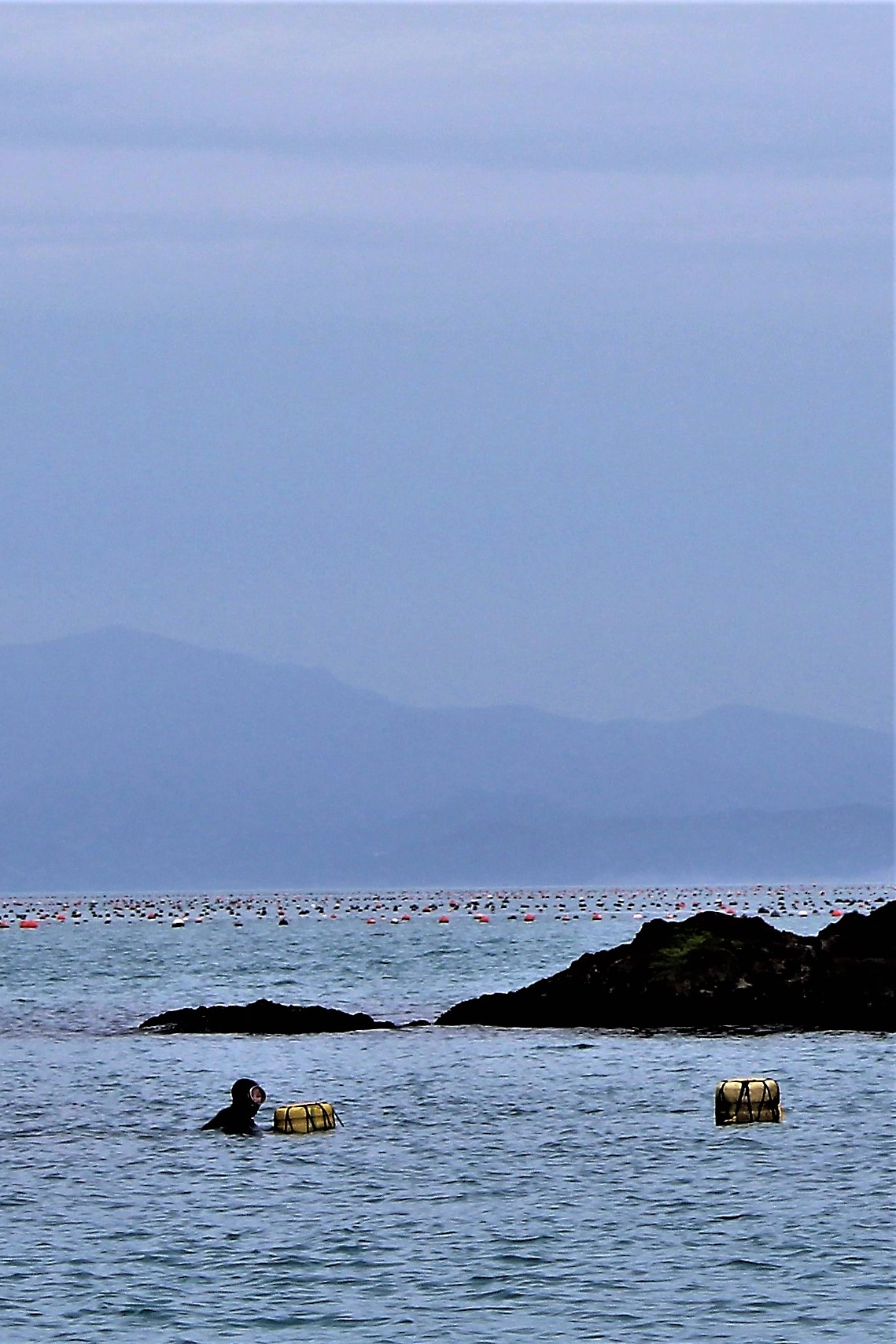
3. Sustainability Efforts are readily employed (benefit of all not just collected species, understanding of holism of environmental systems illustrating TEK)
The intricacies of Haenyeos’ TEK understanding are multi-tiered and complex. The observations and comprehension of the environmental systems and fluctuations on any given day, as outlined in the above sections, have led to honed sustainability practices that Haenyeo have been implementing and expecting system-wide in all ecosystems that they have been gathering within. There are rules and regulations that have been implemented for supporting and promoting oceanic natural resources’ health and sustainability (Haenyeo Museum 2014). These system-wide practices are vital for the health and viability of the ecosystems, natural resources, species continuation. Sustainability efforts of this proportion that the Haenyeo undertake and adhere to, are remarkable and applaudable. Haenyeo themselves openly discussed the measures that they take, as well as holding everyone accountable to the policies and rules that have been established. These are well documented and strictly enforced. Haenyeo enforce these policies and practices for the wellbeing of the environment and the ongoing ability to continue collection and gathering practices. These implementation efforts have far-reaching positive effects and are lauded by conservation agencies worldwide, but were initiated long before these types of efforts were introduced and acknowledged globally. The Haenyeo Museum exhibits clearly show the Traditional Knowledge (TK) along with TEK practices, as well as the lengthy and careful responsibility that Haenyeo employ. The museum documentation illustrates longstanding harvest adjustment and sustainability practice implementation as a direct result of the multiple generations of TEK these women possess. Critical observation and environmental caretaking practices via Traditional Knowledges in a holistic manner that the Haenyeo engage in, are hallmarks of TEK as well as the place-based reciprocal relationship indigenous groups maintain with their environments. Having such industry-wide standards far earlier than other industries also incorporates the deep seated TEK understanding of environmental conditions, allowing TEK implementation into community-wide efforts for sustainability. This TK provides a TEK system to be firmly established, acknowledge, upheld, and thereby a need for implemented policies along these TEK principles. This leads to improved holistic sustainability efforts, continued reciprocative relationships, as well as TEK being shared and kept invigorated as a vital and essential aspect of not only community, but as an industry-wide foundation system.
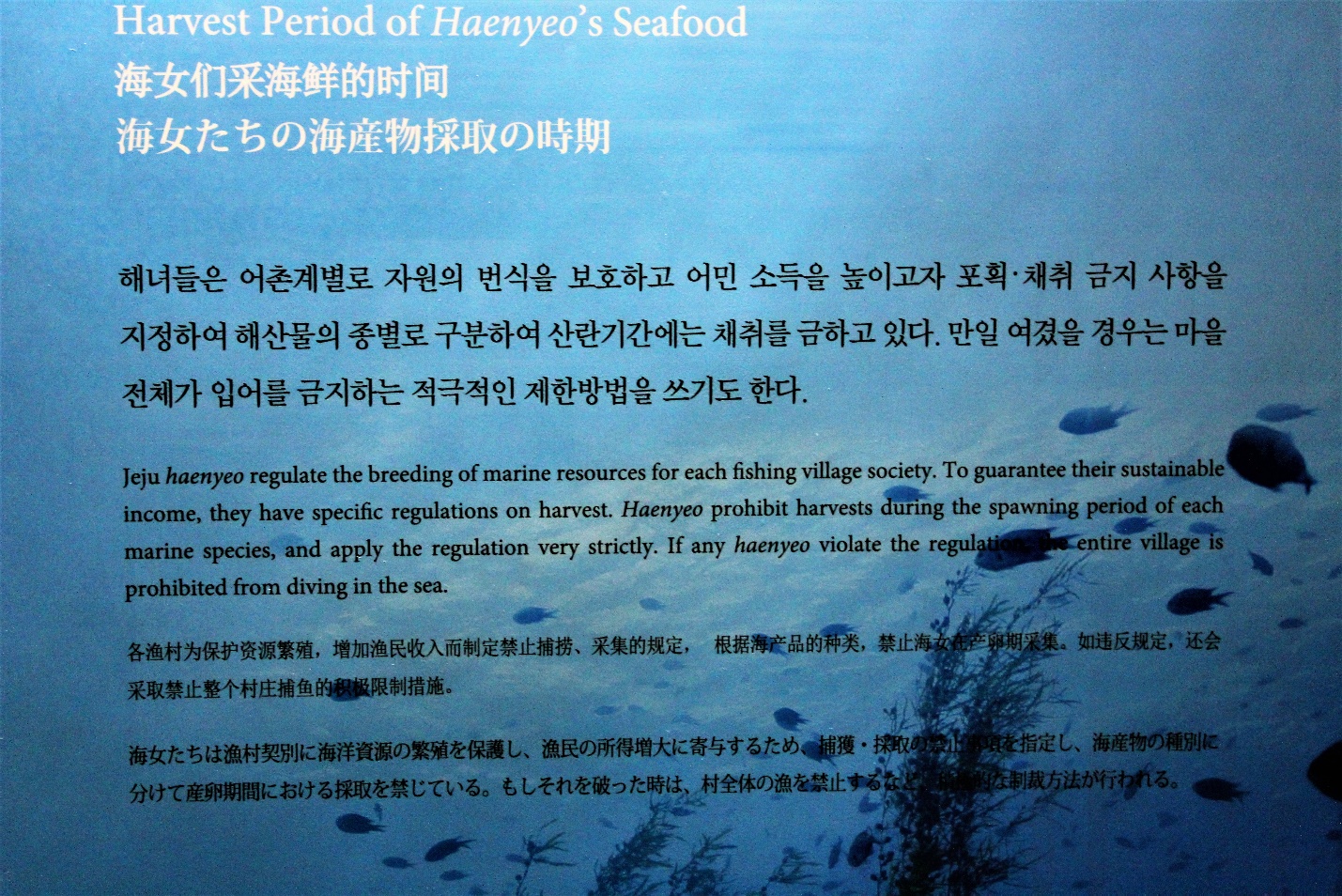
4. Cultural traditions are being honed and vitality of culture has become extended (community, economic draw, diving schools).
With the continuance and support for the TEK which is an integral aspect of the community, multiple other aspects of culture are being supported as well. Through the Traditional Ecological Knowledge systems being maintained, passed down, and preserved for the future, the culture is thereby enriched and enhanced in an ongoing and continual manner. This transference of their unique, detailed knowledge system continually nurtures the foundational aspects of community. It provides the network of information to allow development and sustainability of economic draw, and furthering of education of not only the craft itself but of the environment, health of ecosystem, and identification of adaptation measures. Haenyeo culture is very precise in the aspects of TEK and cultural behaviors. This specific and unique aspect of cultural attributes grounded in TEK, is also shared by Island communities’ adherence and extension of attributes (Hong et al 2018, Lazrus 2012). The celebration and promotion of this TEK assists current and future generations continue the resilience embedded within the culture, as well as provide economic viability through the tourist and ecotourism practices. The island of Jeju has been promoting Haenyeo as a cultural resource as well as other aspects of island natural resources, which help provide a continual reciprocity for the aspects on which the island is founded. Not only is the cultural tradition and history being preserved, but also celebrated and enhanced as a living heritage (You et al. 2018).
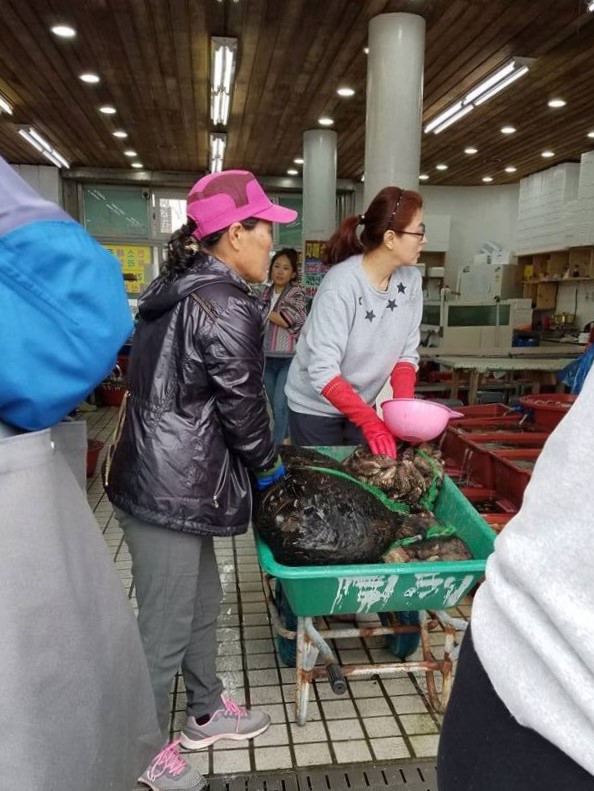
Interpretation analysis
The Haenyeo that migrate to different locations, or that noted having previously migrated from one area to another, also articulated the ability to accurately read and interpret the environment for their highly specialized work. As such, knowing and imparting this knowledge becomes a duty for the Haenyeo who teach and guide the lesser experienced in rank. The responsibilities of Haenyeo who are older and higher in status becomes a vitally important one, and quite literally one of life and death. The ability to discern tides, movements (animal, plant, water), phenology, weather patterns, sudden environmental changes, as well as currents and possible dangers such as warming trends that bring new species into the area is a vital skill. This TEK ability of reading the environment and understanding intricate place-based ecosystems is one of the hallmarks of Traditional Ecological Knowledge and can be attributed to the Haenyeo’s abilities to understand and predict trends better than others who utilize scientific methodologies alone. The intricacies of understanding from the observation and understanding of the environmental systems and fluctuations have led to honed sustainability efforts. Minute details of change and fluctuation are noted, based on near-daily interactions, and therefore have a much more in-depth knowledge of the changes and requirements of adaptation that must occur. Understanding the influx of changes and noting how it has impacted local species has been articulated through Haenyeo interviews. These women noted specific environmental aspects which have been difficult to obtain, along with the need to alter patterns of harvesting and collection. Warming weather, ocean temperatures, and increased red tide events have all been noted through western science but the Haenyeo have been noticing the impacts on species that have been abundant and readily relied on for income and consumption purposes. These articulations should be more closely paid attention to, as these women hold important information regarding environmental circumstances, changes and could greatly assist in sustainability practices.
Because these women have a highly developed system of collection, and reading the environment is a requisite for not only understanding the ecosystems they live and work in, but also as a means of literal survival, this group of divers could easily be referred to as ecological front-line indicators. Their specialization, close reciprocal relationship with their environment, as well as cultural adherence are absolutely vital for the systems in which they live and work. The Haneyeo’s intricate understanding of the ebb and flow of TEK is clearly articulated in helping guide their continual adaptation measures that are employed. This adaptation system leads to honed sustainability practices that are mandatory for the ecosystems they effectively manage. These women are on the front lines of the health and welfare of their respective islands, leading the way and noting changes and utilizing sustainability efforts prior to any other entity bringing this information forth. These women are quite literally the first responders of the seascapes they traverse, responsible for assisting, protecting, and maintaining health and wealth. The environmental systems, as well as supporting and maintain of cultural traditions is an integral aspect of these communities’ economic livelihood, along with the ecosystem health of these areas. It is not without exaggeration to say that these women have been the foundational systems for multitudes of sustainable harvest practices, biodiversity initiatives, indications of the environmental quality, and the cultural welfare of their communities along with the extended island communities as well as the economic health, and vital tourism they attract. The abundance of information, including longstanding historical information, documents the Haenyeo’s achievements, and efforts to utilize sustainable collection practices and maintain healthy vibrant ecosystems. Most of the TEK information that these women possess regarding their surrounding communities is elaborate, multi-tiered, efficient, effective, and held in high regard. The information system they have establish has wide-reaching effects and is system-wide amongst communities and extends into the mainland areas. To say that the Haenyeos’ Traditional Ecological Knowledge system is highly developed, skilled, and yet underrated internationally, is an understatement. Although highly regarded socially, this intricate and valuable scientific environmental knowledge is not as promoted, or appreciated as highly as the tourism and economic aspects have been.
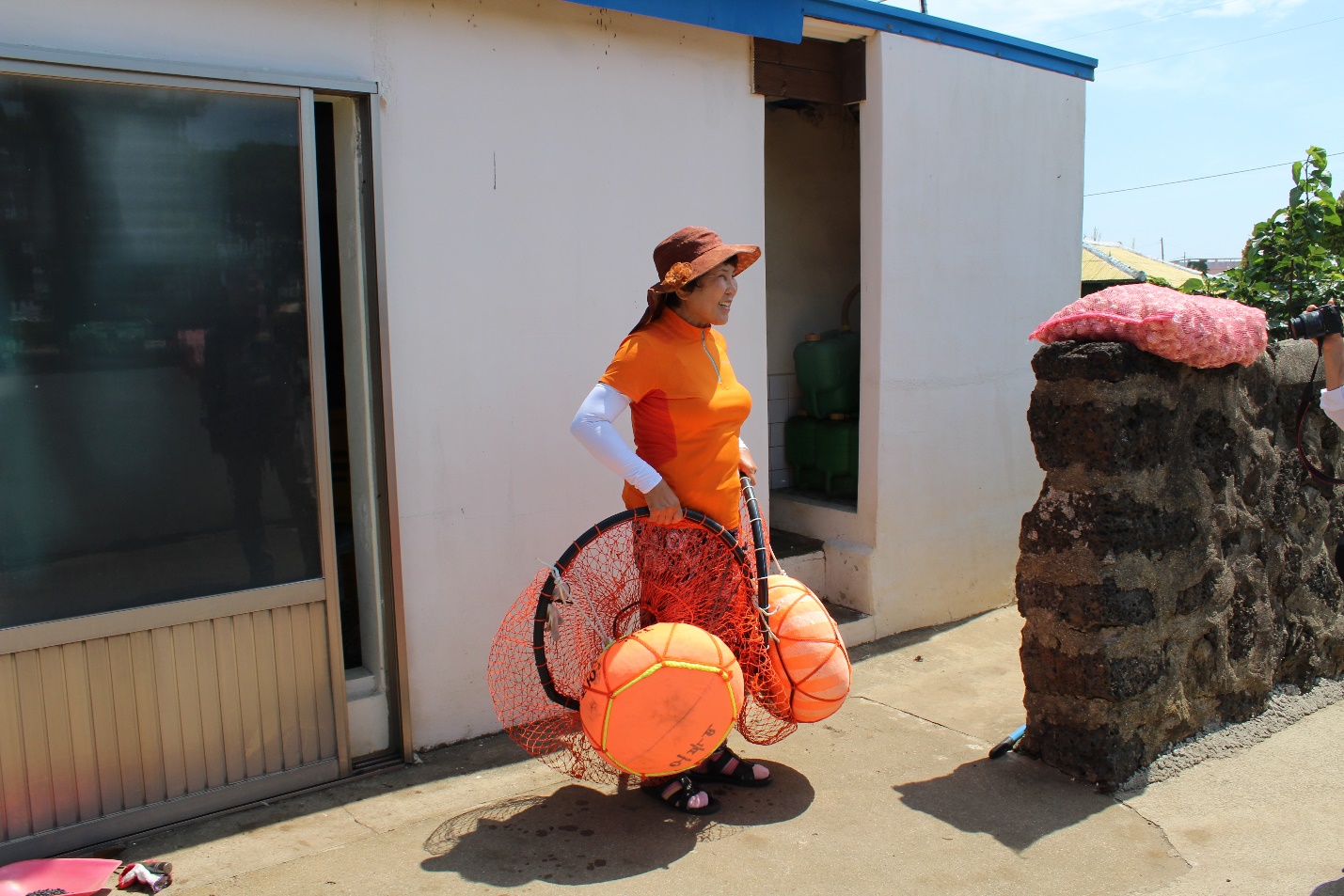
Conclusions and recommendations
The Haenyeos’ TEK is a vital piece of the islands’ welfare and ability to facilitate and mitigate climate change events. As increasing species are impacted, these women will be one of the first groups to be able to note exactly how the changes are impacting the resources and health of the ecosystems. These women hold environmental knowledge which is key for survival practice on multiple levels, and need to have further assistance in areas that help them perform their work, sustainability, and reciprocity activities. Interdisciplinary scientific verification of phenology and seasonal timing needs to be examined alongside Haenyeo TEK. These women have been routinely documenting phenology and other ecological events at area island locations, information which coincides with much of the climate change research being done in island areas. Support that should be extended to assist the Haenyeo’s practice and developing knowledge systems would include such items and events that fall into categories that many overlook; ceremonial, and religious blessings are extremely important cultural aspects to the harvesting and timing facets of this complex culture, linked in with phenological aspects of harvesting collections. Increased, quality research is needed for the properties of the Haenyeo’s endeavors, practices, and unique TEK, above and below seascape surfaces. Adequate research which is seated in understanding Haenyeo practices and cultural systems which are interwoven with the landscape is vital. Further research is also needed that addresses environmental issues which are new unique challenges, and that will only increase as climate change impacts continue to affect ecosystem health and livelihoods. Along with a better understanding of the Haenyeo’s adaptation and sustainability measures, better understanding the changes in the environment would assist the country’s understanding and readiness for climate change effects. Some of these effects are a result of the ensuing climate change issues that have been steadily increasing; some of which are currently being experienced, and whose continuance seems inevitable. The adaptation measures the Haenyeo have employed seem effective and relative to the impacts that they are experiencing. These adaptations should be looked at more closely to analyze what can be applied for mainland populations who will be impacted in the near future from similar events, as well as marine areas and food sources which rely on ocean dwelling species. Enlisting assistance and gathering knowledge from these mermaid superwomen of the sea would prove wise in preparation for depletion of resources and inevitable changes due to ecological shifts.
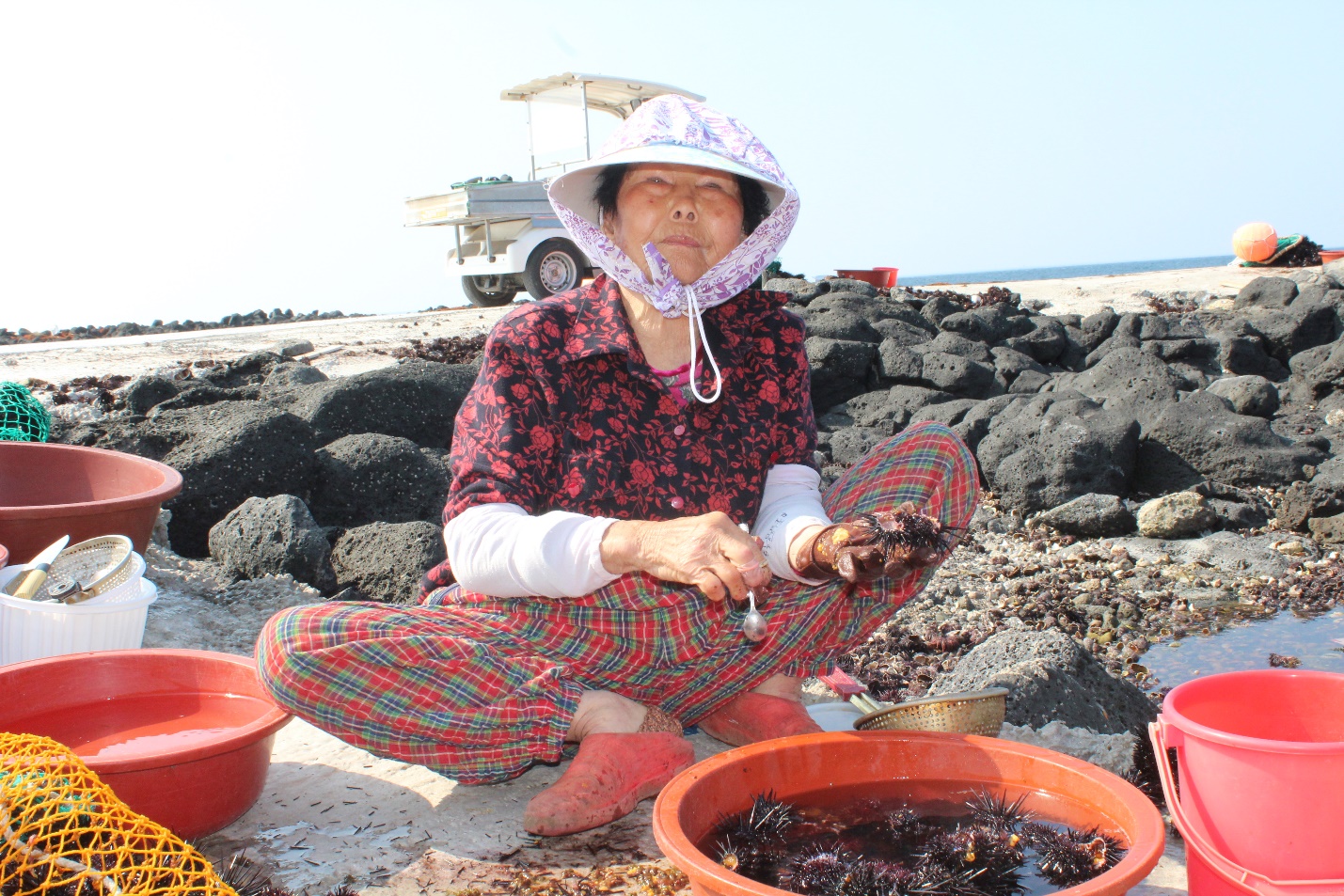
Acknowledgements
This research was conducted with the support of National Research Foundation of Korea (NRF-2009-361-A00007) funded by Korean government (Ministry of Education, Science and Technology) in 2009. Special thanks go to the Korea Foundation for the supporting field research fellowship awarded to Dr. Samantha Chisholm Hatfield, and to the Korean Oral History Association, and the Society for Jeju Studies. We also would like to thank the Haenyeo for taking the time to speak with us, Professor Chul-in Yoo of Jeju National University, Professor Mi-Jung An of the Korea Maritime and Ocean University, Mr. Kyoung-Wan Kim, and Ms. Mi-ra Cho of Mokpo National University for their help with island surveys, interpretations and island guidance.
References
- Adger WN, Hughes TP, Folke C, Carpenter SR, Rockström J. 2005. Social-ecological resilience to coastal disasters. Science 309: 1036–39
- An, Mi-jeong. 2008. “Osaka Jaeil Jejuin yeoseong ui iju wa gwihyang” (The Migration and Return Home of Osaka zainichi Korean Females from Jeju Island) (in Korean). Tamla Bunka (Tamla Culture) 32: 179–218. Jeju University Tamla Cultural Research Center.
- Byun, K., Kang, E.J., Yoo, C. and Kim, K.H., 2015. Spatial Transformation and Functions of Bulteok as Space for Haenyeo on Jeju Island, Korea. Journal of Asian Architecture and Building Engineering, 14(3), pp.533-540.
- Byun, K., Kang, E.J., Yoo, C. and Kim, K.H., 2015. Spatial Transformation and Functions of Bulteok as Space for Haenyeo on Jeju Island, Korea. Journal of Asian Architecture and Building Engineering, 14(3), pp.533-540.
- Chisholm Hatfield, S., Hong S.K. 2017. Islanders of South Korea: Culture, Climate Change, and Traditional Ecological Knowledge. Journal of Marine and Island Cultures 6(2): 64-77.
- Fagan B. 2008. The Great Warming: Climate Change and the Rise and Fall of Civilizations. New York: Bloomsbury.
- Harvey, D. A., Hyun, K.-U. 2015. Heroines of the Sea, Women Divers on Jeju Island. South Korea. Retrieved from: https://www.magnumphotos.com/arts-culture/society-arts-culture/jeju-haenyeo-women-divers-on-jeju-island/
- Hong S.K. 2010. Island ecology on biological-cultural diversities and human adaptation in seascapes. Journal of Ecology and Field Biology 33(2):115–120
- Hong, S.K. 2013. Biocultural diversity conservation for island and islanders: Necessity, goal and activity. Journal of Marine and Island Cultures 2, 102-106.
- Hong, S.K., 2011. Biocultural diversity and traditional ecological knowledge in island regions of Southwestern Korea. Journal of Ecology and Environment, 34(2), pp.137-147.
- Hong, S.K., 2011. Eco-cultural diversity in island and coastal landscapes: conservation and development. In Landscape Ecology in Asian Cultures (pp. 11-28). Springer-Tokyo.
- Hong, S.K., Bogaert, J. and Min, Q. eds., 2014. Biocultural landscapes: diversity, functions and values. Springer.
- Hong, S.K., Nakagoshi, N., Fu, B.J. and Morimoto, Y., 2008. Landscape Ecological Applications in Man-Influenced Areas-Linking Man and Nature Systems. In Landscape Ecological Applications in Man-Influenced Areas (pp. 1-6). Springer Netherlands.
- Ijichi, N., 2016. Imperial Japan and the Female Skin Divers (Chamsu) of Jeju Island, South Korea. In Rethinking Representations of Asian Women (pp. 51-67). Palgrave Macmillan, New York.
- Ijichi, Noriko. 2000. Seikatsu sekai no souzou to jissen—Kankoku Saishuu-tou no seikatsushi kara (The Creation and Practice of Everyday Life: Life Histories of Jeju Island Korea) (in Japanese). Tokyo: Ocha no Mizu Shoten.
- Jeong, H.J., Lim, A.S., Lee, K., Lee, M.J., Seong, K.A., Kang, N.S., Jang, S.H., Lee, K.H., Lee, S.Y., Kim, M.O. and Kim, J.H. 2017. Ichthyotoxic Cochlodinium polykrikoides red tides offshore in the South Sea, Korea in 2014: I. Temporal variations in three-dimensional distributions of red-tide organisms and environmental factors. Algae, 32(2), pp.101-130.
- JM Nuri Co., Ltd. Ed. Haneyeo Museum. 2014. Jeju Haenyeo. Jeju-si, Jeju.
- Jo, S.J., 2018. Tide and Time: Korean Fishermen's Traditional Knowledge of Multtae in Gomso Bay1. International Journal of Intangible Heritage, 13, pp.208-222.
- Jun, K.S., Chung, E.S., Kim, Y.G. and Kim, Y., 2013. A fuzzy multi-criteria approach to flood risk vulnerability in South Korea by considering climate change impacts. Expert Systems with Applications, 40(4), pp.1003-1013.
- Kim, J.E. and Hong, S.K., 2009. Landscape ecological analysis of coastal sand dune ecosystem in Korea. Journal of the Korea Society of Environmental Restoration Technology, 12(3), pp.21-32.
- Kim, S., 2003. Jeju Island Women Divers' Association in South Korea: A Source of Social Capital. Asian Journal of Women's Studies, 9(1), pp.37-59.
- Ko, C.H., Kang, K.M., Lim, M.H., Lee, H.Y., Yang, J.K. and Yang, J.C., 2014. An Island Conservation Model of Jeju Haenyeso Cohabitation with Nature in an Age of the Coastal Pollution. World Environment and Island Studies, 4(1), pp.27-45.
- Ko, C.H., Kojetin, D., Kim, D., Kim, J. and Kang, K., 2015. The Opening of a “Green Growth Organization” of the Jeju Declaration from WCC 2012 Actualizes as Establishment of an ASIAPARC Federation, Partnership Organization of EUROPARC Federation in 2016. World Environment and Island Studies, 5(2), pp.101-109.
- Ko, C.H., Kyeong-min, K., Myung-ho, L., Han-young, L., Jin-kyu, Y. and Jung-Cheol, Y., 2014. An Island Conservation Model of Jeju Haenyeo Cohabitation with Nature in an Age of the Coastal Pollution. World environment and Island Studies, 4(1), p.2746.
- Ko, J.Y., Jones, G.A., Heo, M.S., Kang, Y.S. and Kang, S.H., 2010. A fifty-year production and economic assessment of common property-based management of marine living common resources: a case study for the women diver’s communities in Jeju, South Korea. Marine Policy, 34(3), pp.624-634.
- Lazrus, H., 2012. Sea change: island communities and climate change. Annual Review of Anthropology, 41.
- Lee, C.K., Park, T.G., Park, Y.T. and Lim, W.A., (2013). Monitoring and trends in harmful algal blooms and red tides in Korean coastal waters, with emphasis on Cochlodinium polykrikoides. Harmful Algae, 30, pp.S3-S14.
- Lee, D.K., 2008. Cochlodinium polykrikoides blooms and eco-physical conditions in the South Sea of Korea. Harmful Algae, 7(3), pp.318-323.
- Lee, J.H. and Iwasa, Y., 2011. Tourists and traditional divers in a common fishing ground. Ecological Economics, 70(12), pp.2350-2360.
- Lee, J.H. and Iwasa, Y., 2014. Modeling socio‐economic aspects of ecosystem management and biodiversity conservation. Population ecology, 56(1), pp.27-40.
- Lee, M.O., Kim, J.K. and Kim, B.K., 2016. Factors controlling the origin of Cochlodinium polykrikoides blooms along the Goheung coast, South Korea. Marine pollution bulletin, 113(1-2), pp.165-175.
- Lee, S. and Myong, S.O., 2018. Portraits of Jeju Haenyeo as Models of Empowerment in the Korean Newspaper Maeilshinbo during Japanese Occupation. CLCWeb: Comparative Literature and Culture, 20(2), p.14.
- Lewis J. 1990. The vulnerability of Small Island States to sea level rise: the need for holistic strategies. Disasters 14(3): 241–48
- Lynn, K., MacKendrick, K. and Donoghue, E.M., 2011. Social vulnerability and climate change: synthesis of literature.
- Morss R, Wilhelmi OV, Meehl GA, Dilling L. 2011. Improving societal outcomes of extreme weather in a changing climate: an integrated perspective. Annual Review of Environment and Resources. 36: 1–25
- Nam, W.H., Hayes, M.J., Svoboda, M.D., Tadesse, T. and Wilhite, D.A., 2015. Drought hazard assessment in the context of climate change for South Korea. Agricultural Water Management, 160, pp.106-117.
- Nesheim, M. C., Oria, M., & Yih, P. T. 2015. Committee on a Framework for Assessing the Health, Environmental, and Social Effects of the Food System. Food and Nutrition Board, National-Research.Denis, V., Chen, C.A., Song, J.I. and Woo, S., (2013). Alveopora japonica beds thriving under kelp. Coral Reefs, 32(2), 503-503.
- Qi, L., Hu, C., Wang, M., Shang, S. and Wilson, C., 2017. Floating algae blooms in the East China Sea. Geophysical research letters, 44(22).
- Seong, K.T., Hwang, J.D., Han, I.S., Go, W.J., Suh, Y.S. and Lee, J.Y., 2010. Characteristic for long-term trends of temperature in the Korean waters. Journal of the Korean Society of Marine Environment & Safety, 16(4), pp.353-360.
- Strong, J., 2018. Foraging. In Routledge Handbook of Landscape and Food (pp. 95-102).
- Yoo, S.H. and Jung, Y.S., 1992. Soil management for sustainable agriculture in Korea. ASPAC, Food & Fertilizer Technology Center.
- You, W.H., Seo, S.J. and Choi, B.K., 2018. A Study of Jeju Haenyeo's (Women Diver) Awareness on Self, Community and UNESCO Intangible Cultural Heritage of Humanity (ICH) Designation. Journal of Korean Institute of Traditional Landscape Architecture, 36(1), pp.89-96.
